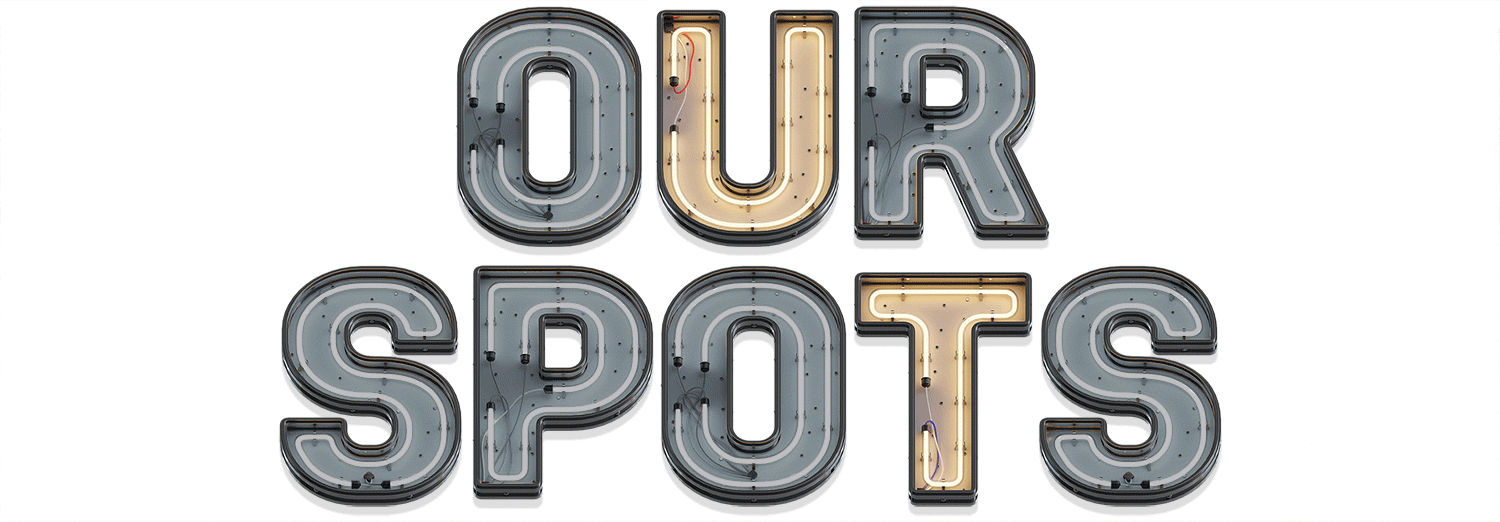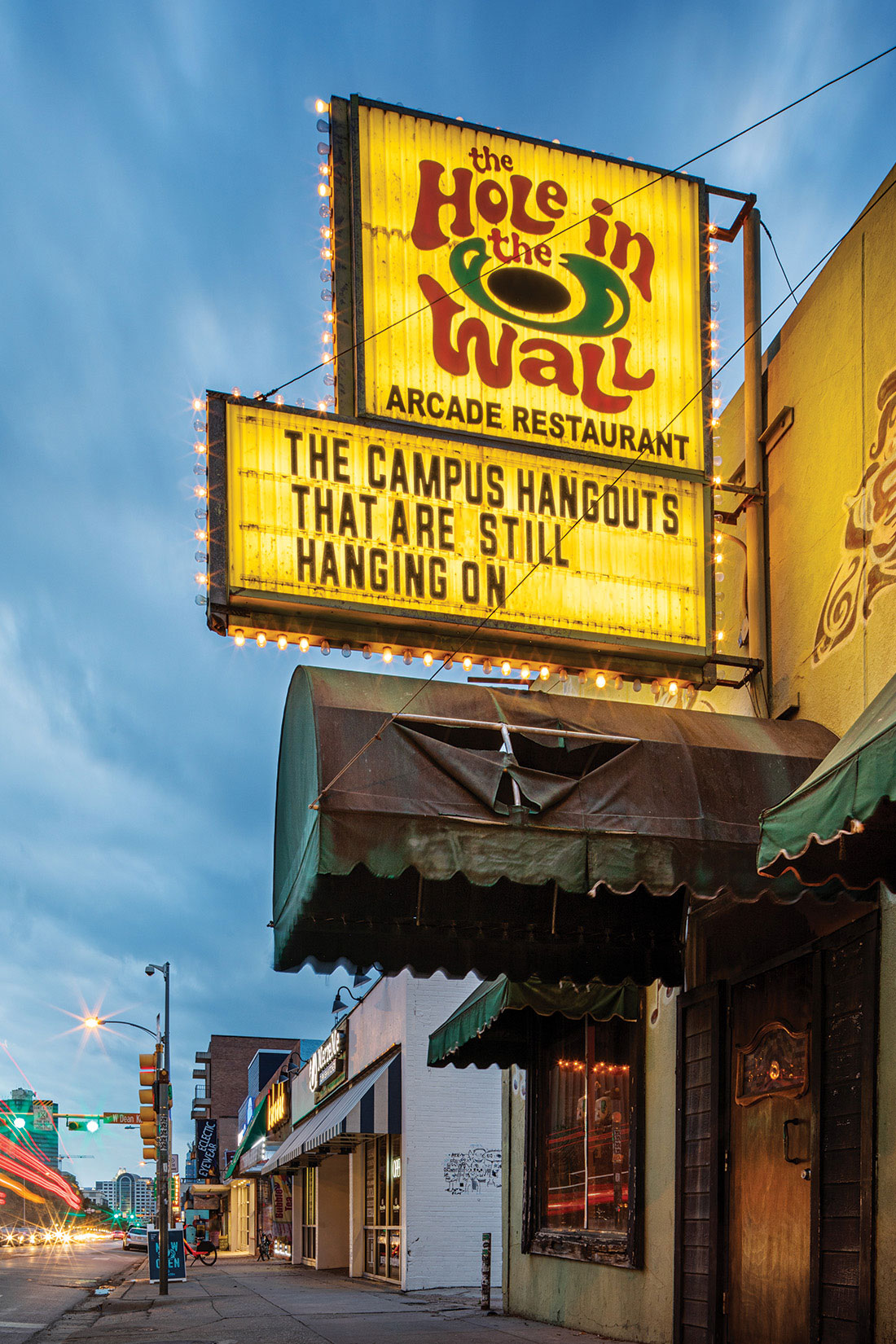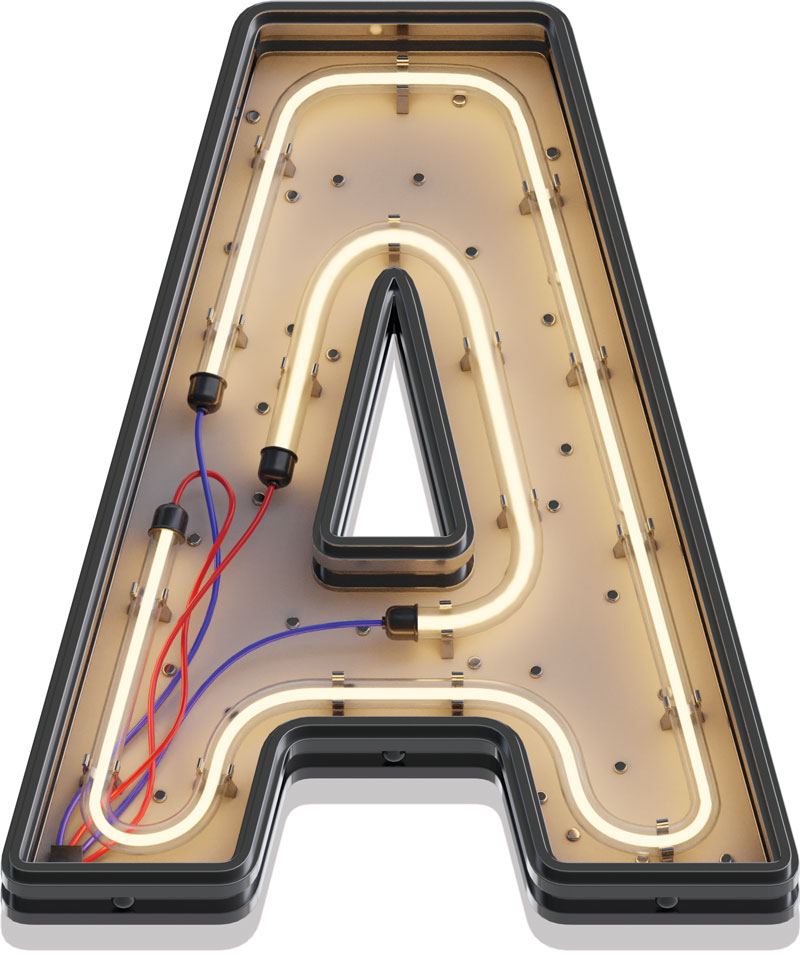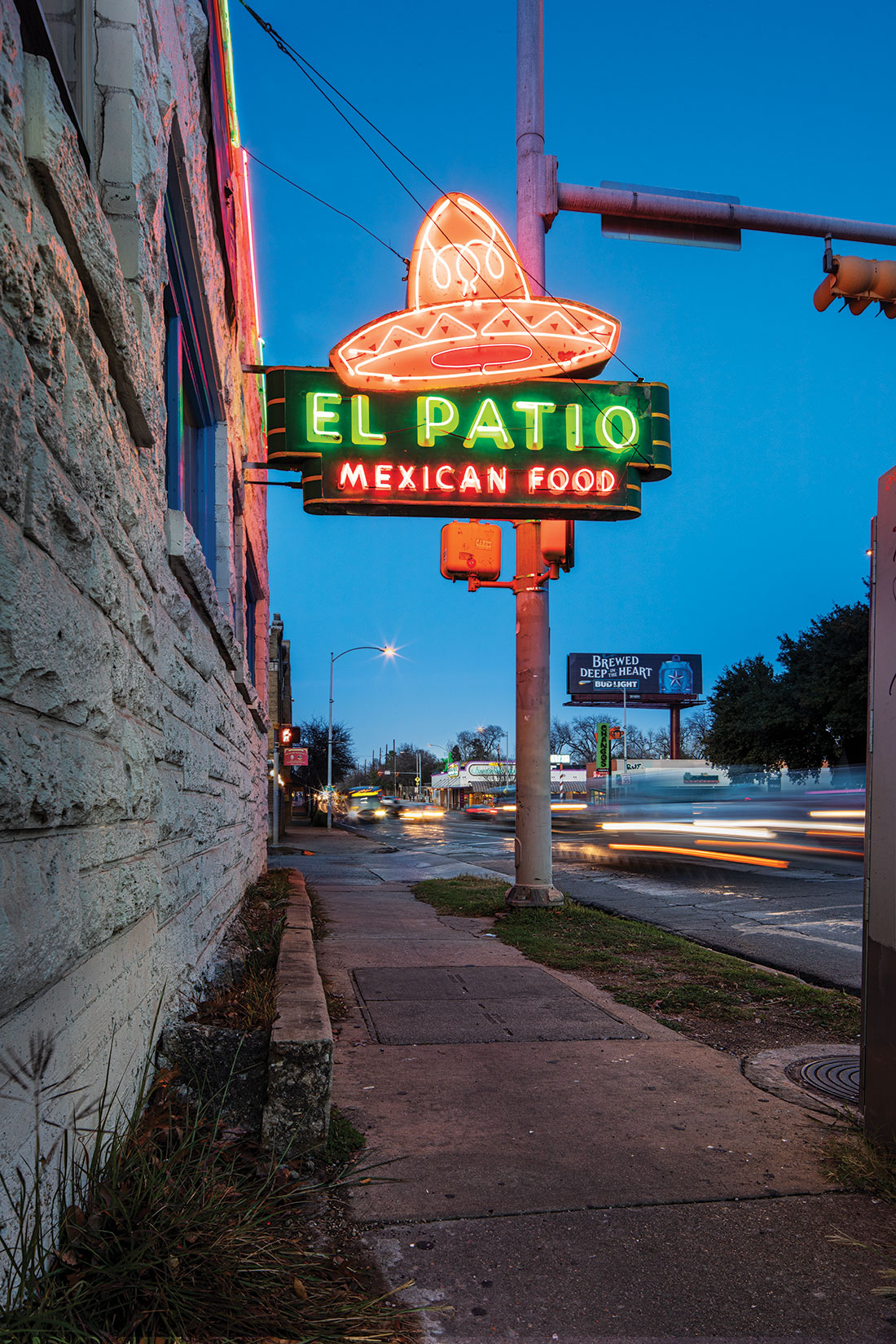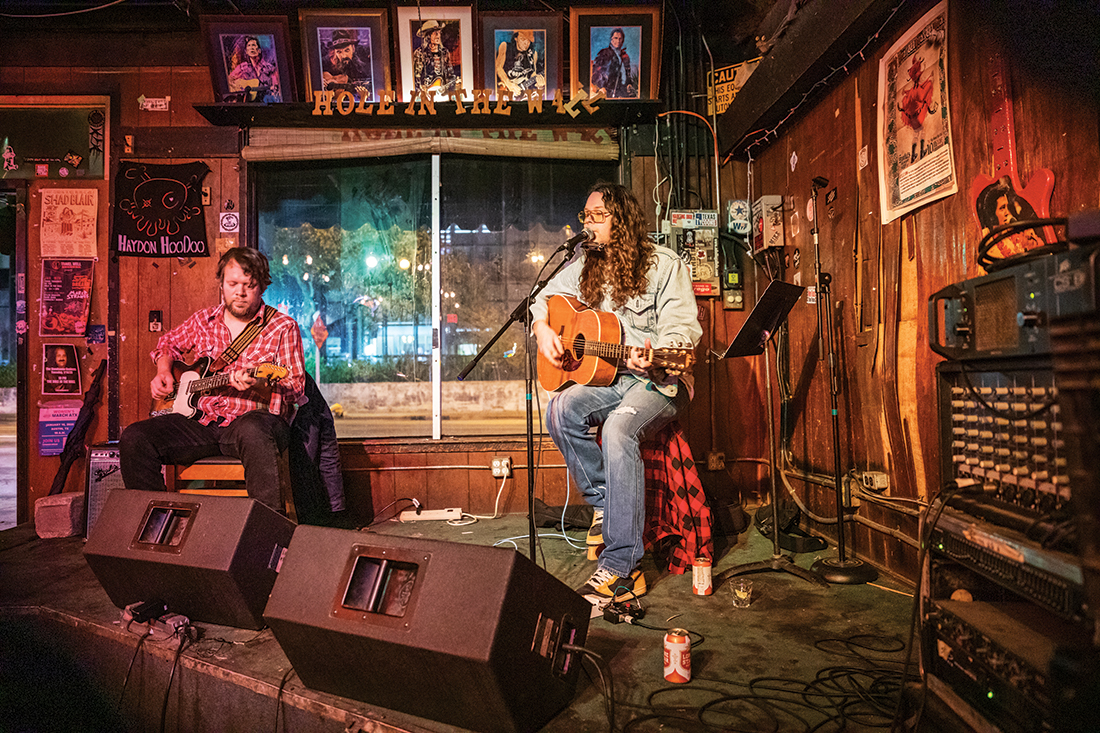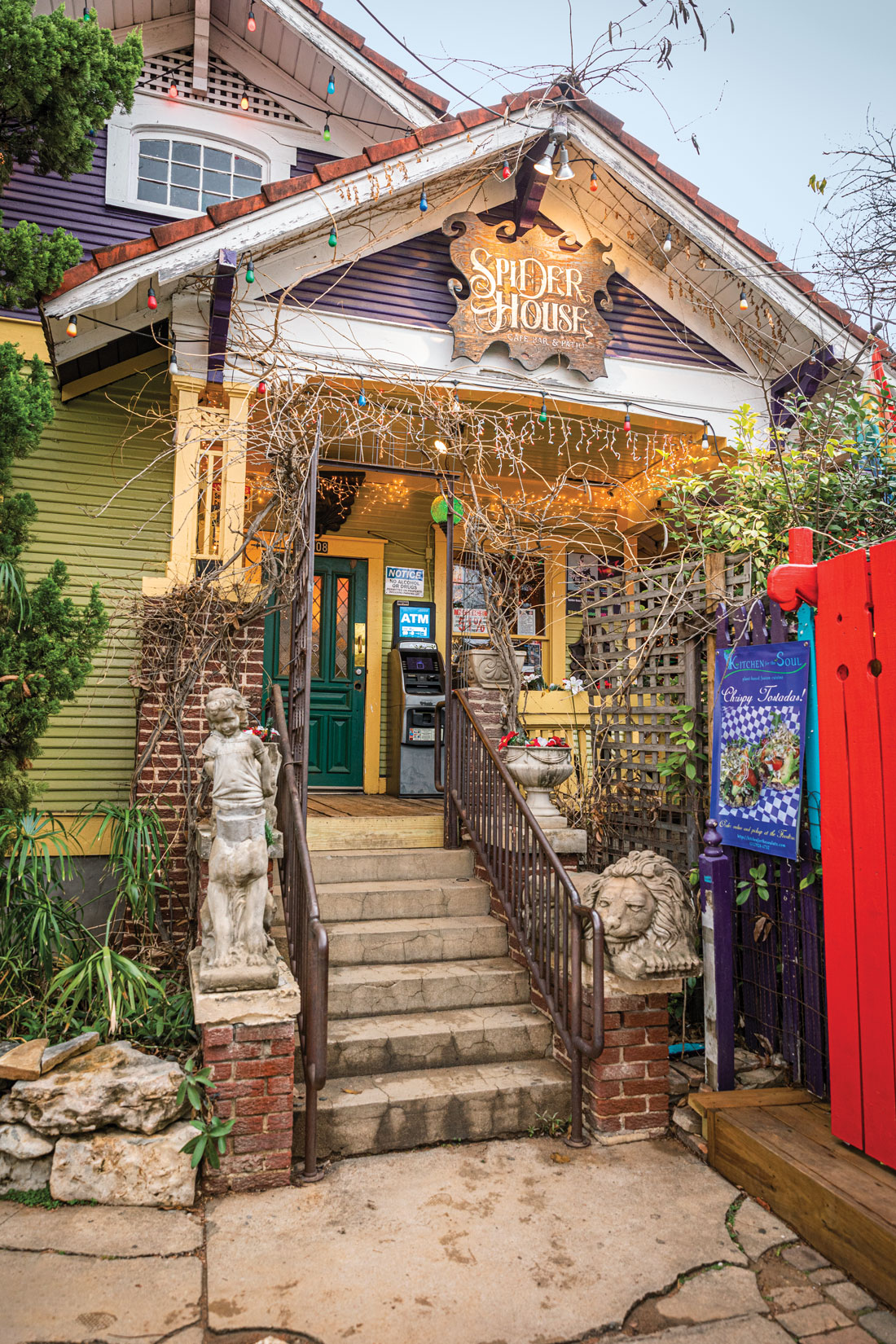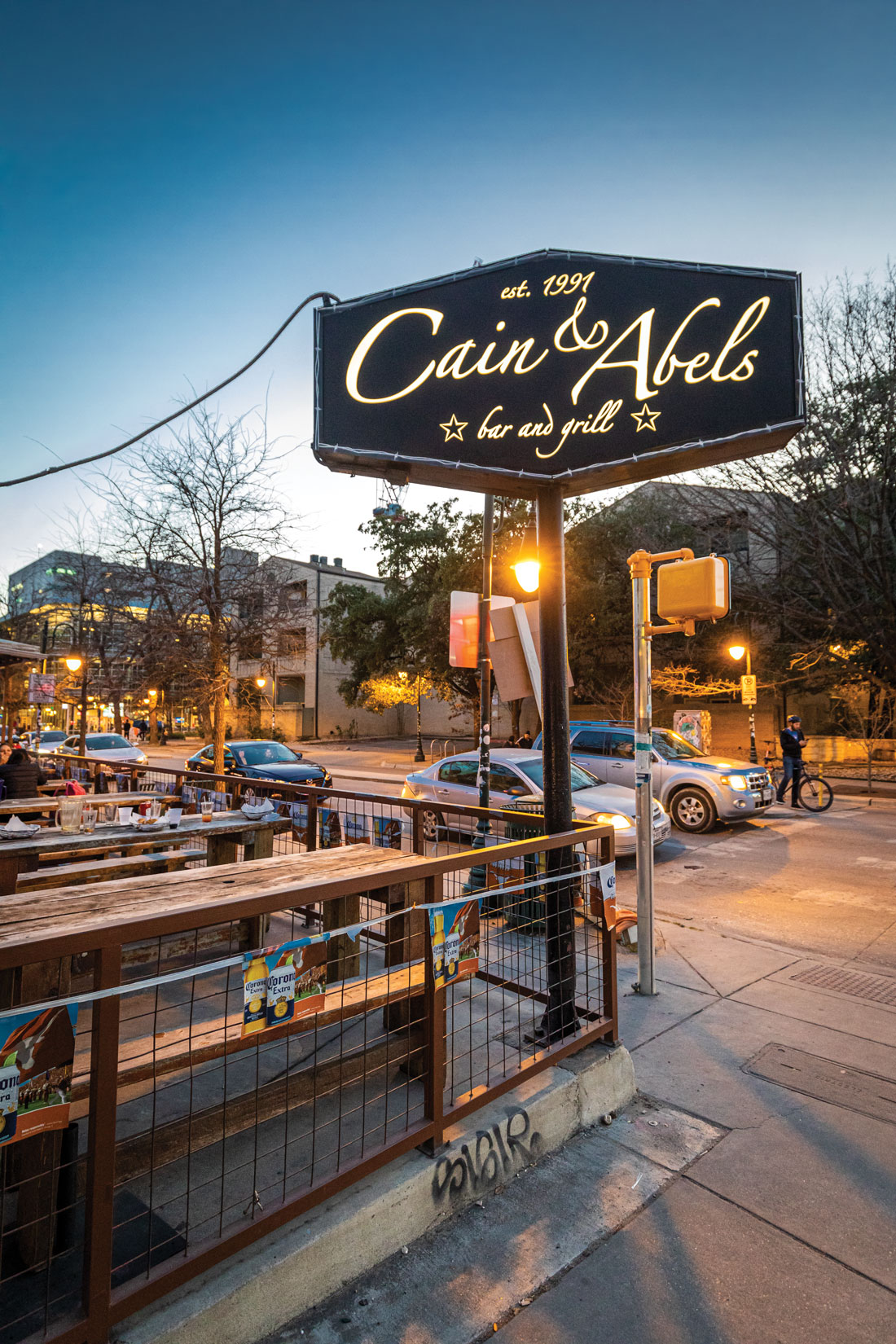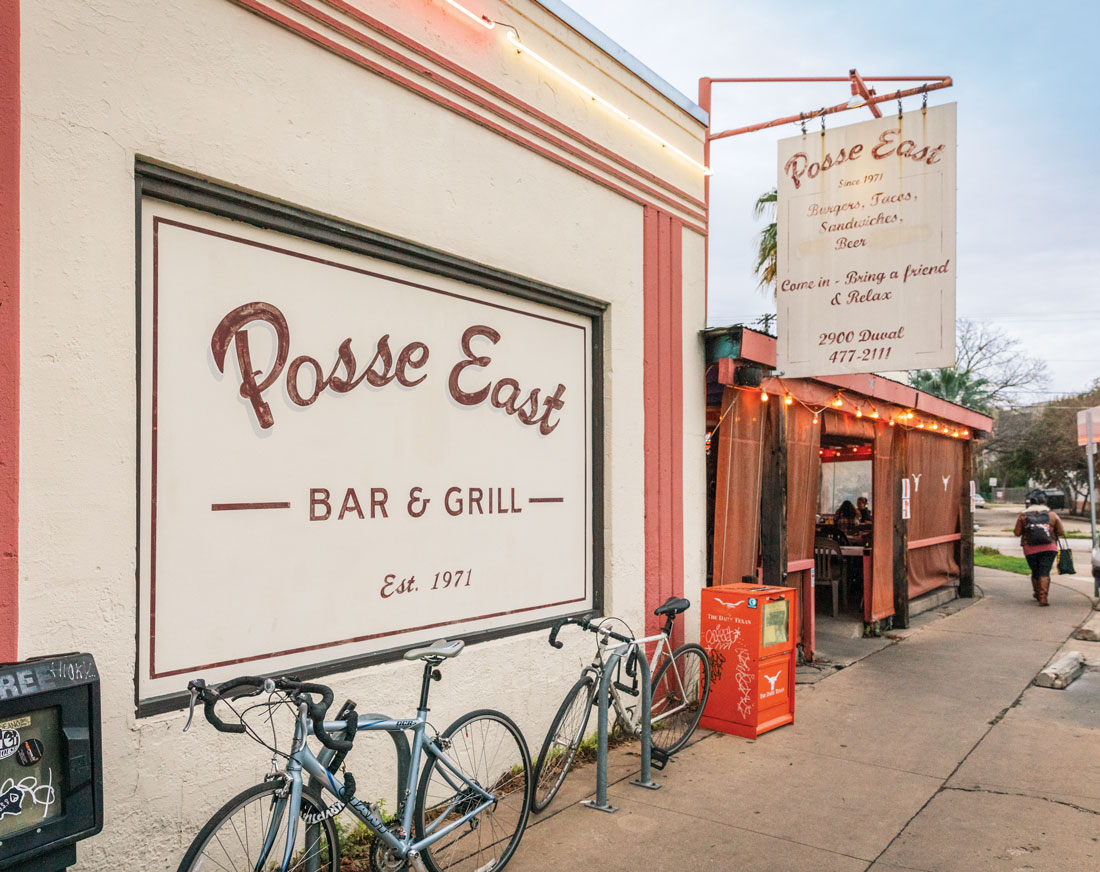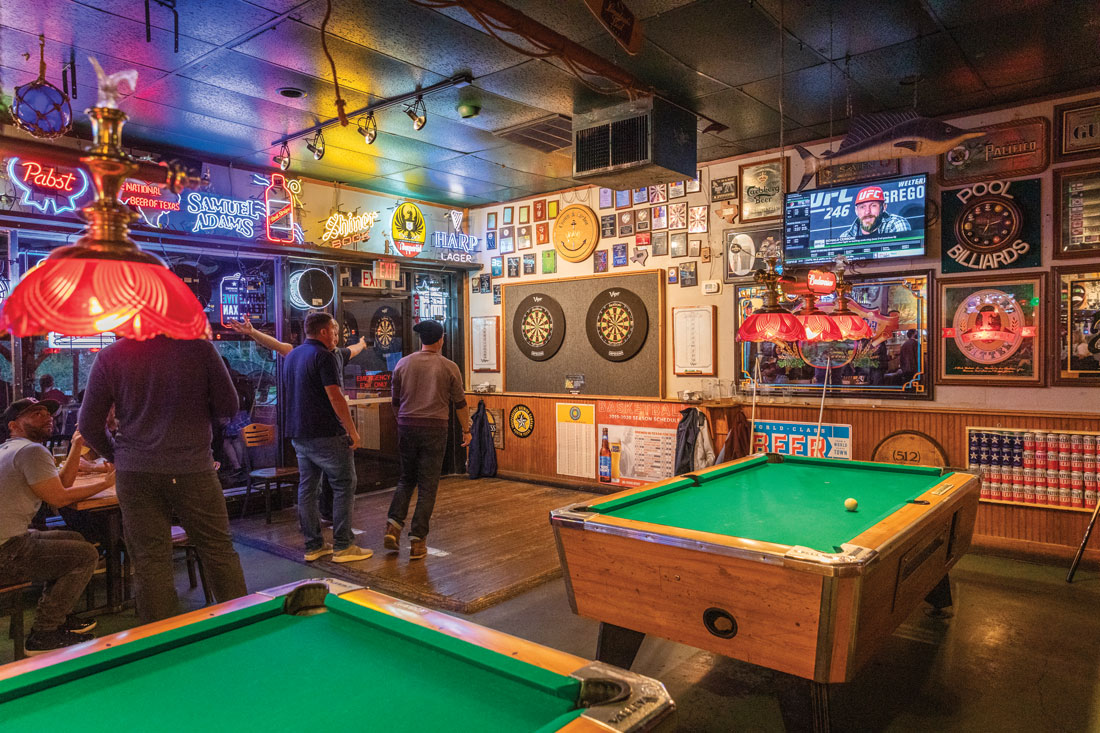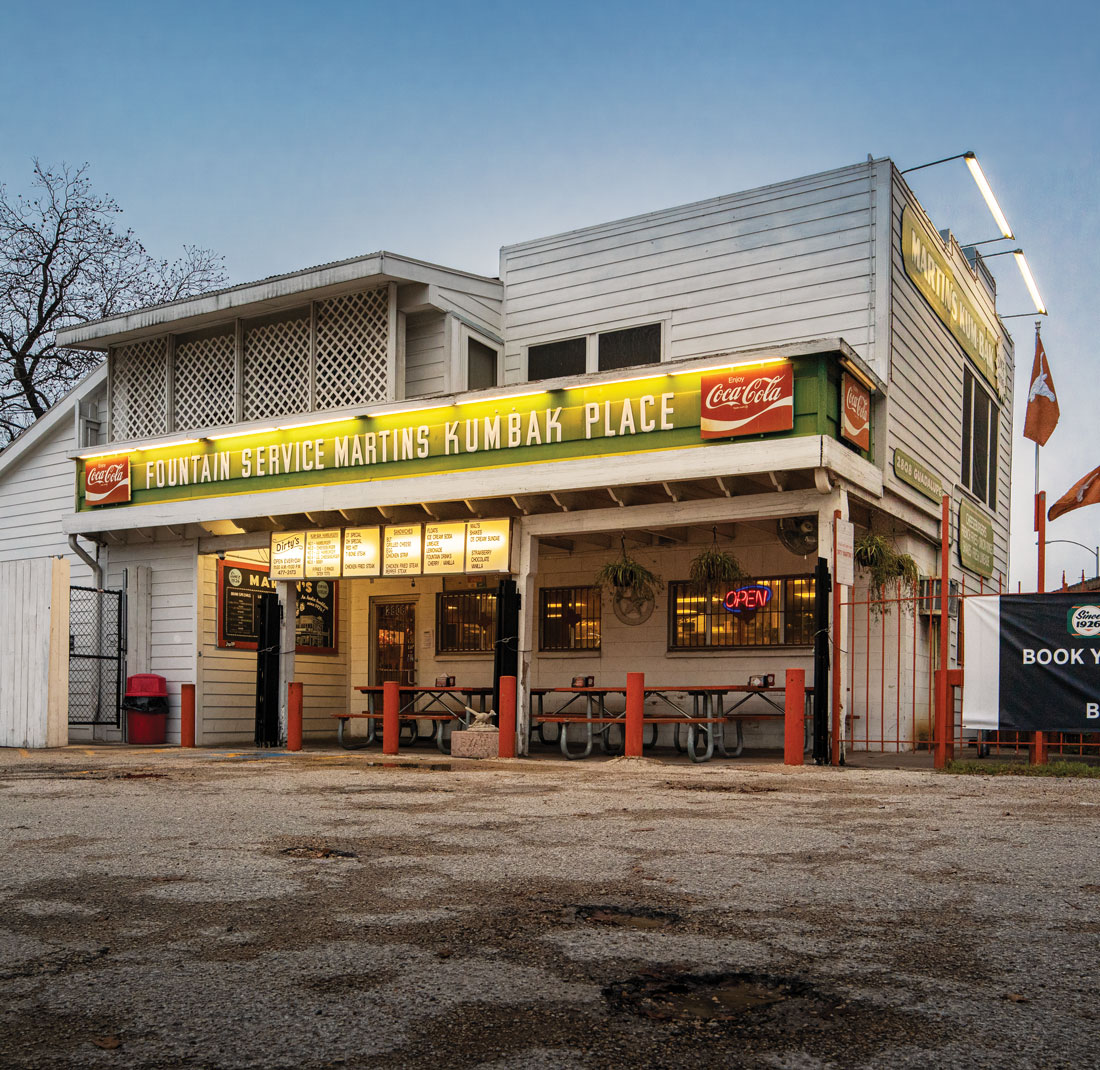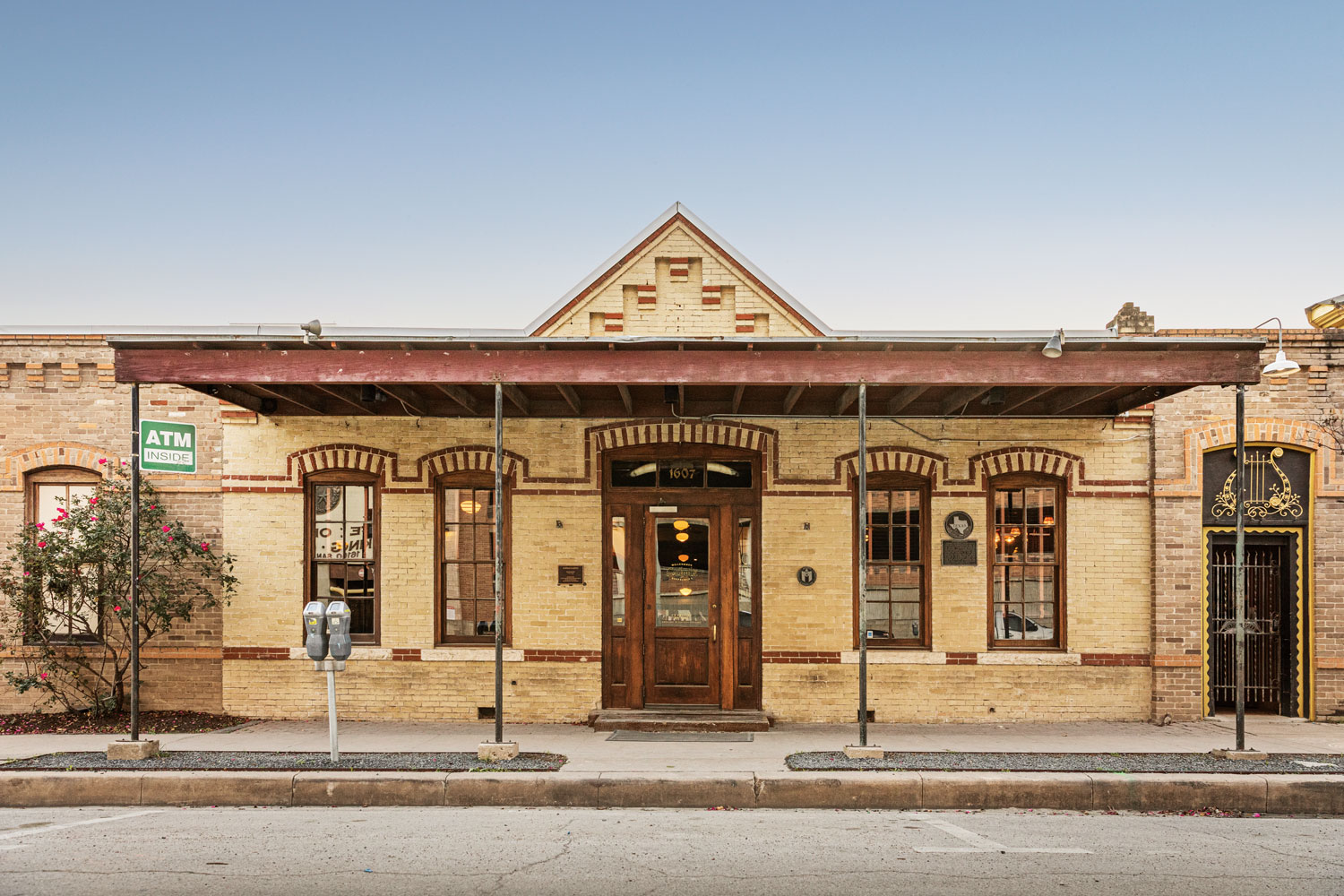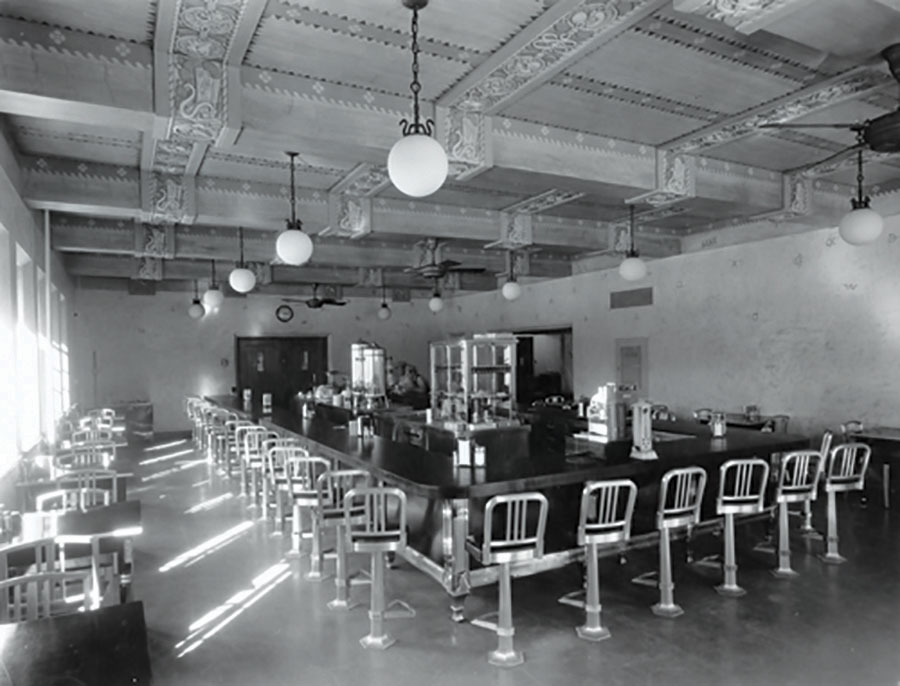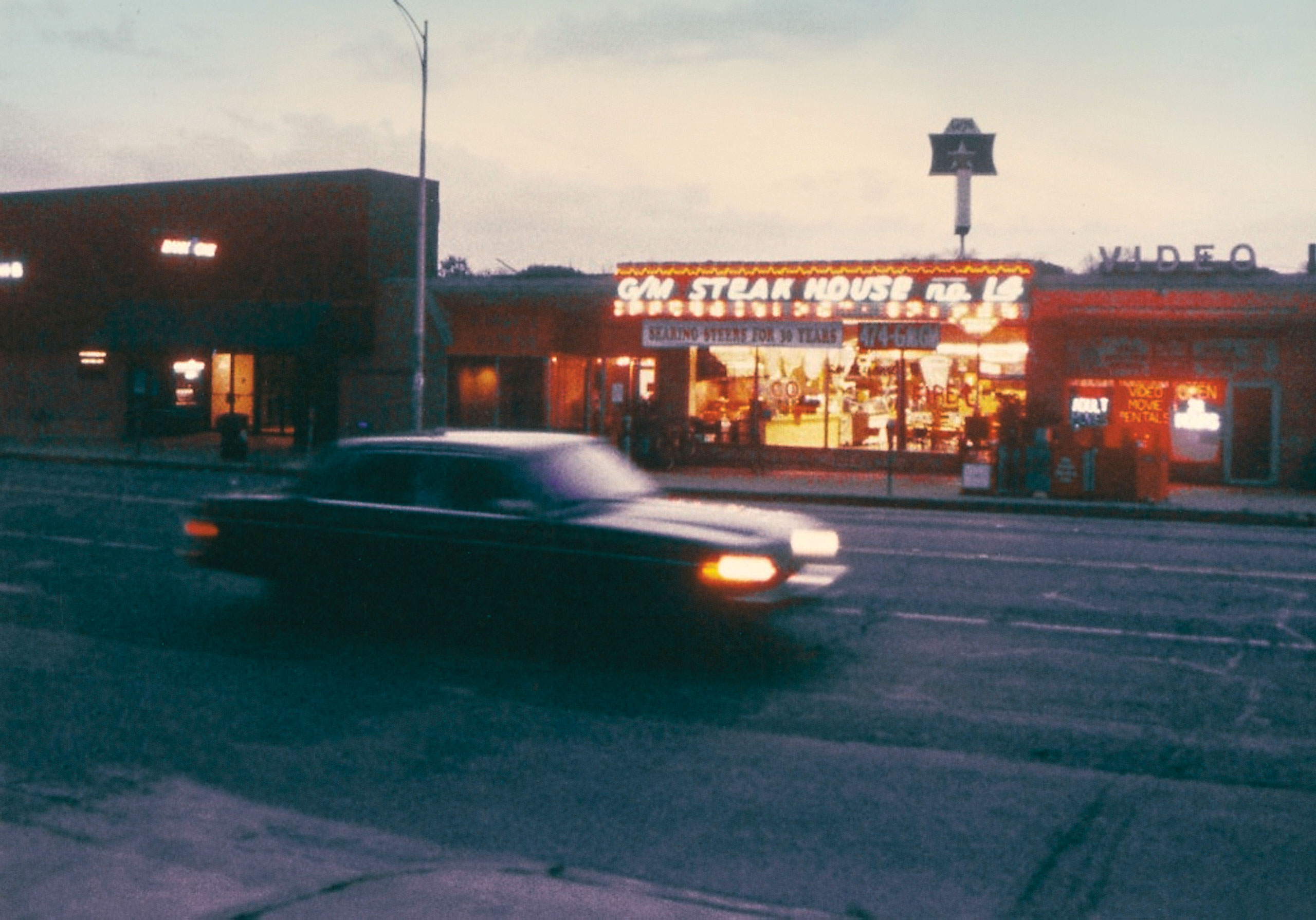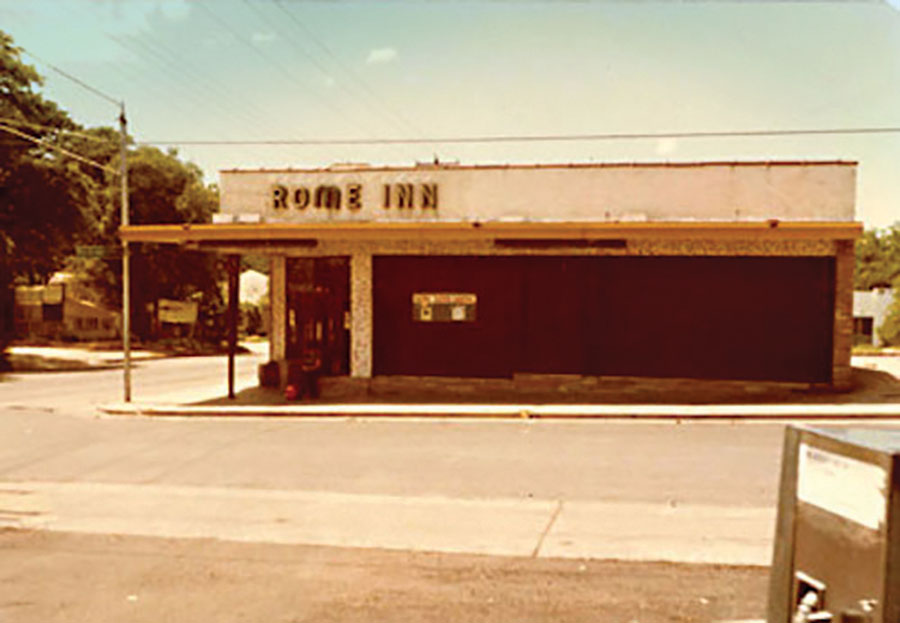From the March/April 2020 issue of the Alcalde
In a city with seemingly as many construction cranes as bats, campus restaurants and bars are turning over constantly. But a few are holding on. These are their stories.
By Andrew Roush and Cat Cardenas
Photographs by Jeff Wilson
restaurant isn’t just a restaurant after six-plus decades—it’s an institution. This past summer, when the news that one of these institutions, El Patio, would be closing its doors after 66 years, there was a multi-generational outcry. UT students had come and gone, but they all remembered the same place, same feel, and same melted yellow cheese. It’s a rarity on the periphery of campus, an area that has seen many cafes, taverns, and movie theaters open and close amid a few mainstays. For many, El Patio was just that. But it’s not nearly the only one. ¶ Institutions belong to the community, and the Austinites and Texas Exes that strolled the Drag for years on their way to that Tex-Mex beacon weren’t satisfied to let the crispy tacos and combo plates go gently into that good night. They raged against the dying of the neon, sombrero-shaped light. And, ultimately, their cries were answered—more on that later. ¶ The places that stay in our memory, places that last for decades, have something different, something ahistorical and enduring. After the emotional rollercoaster of El Patio’s cl-opening saga, we felt compelled to check in on our most beloved campus haunts and take their collective pulse. But first, let us define our parameters: A campus institution should be within walking distance of the main campus. It should primarily serve the university community, and it should last through the machinations of student preference and economic vacillation. That is, it should remain open for at least several years before shuttering—flash-in-the pan favorites will have to wait. ¶ Using this criteria, a few exemplary businesses can be identified. In knowing these spots, we might also learn a bit about the character of the university, namely its collective likes and dislikes. And if we’ve learned anything, one thing the UT community has liked for decades, and probably will continue to like for decades more, is a massive plate of enchiladas.
Jump to: El Patio • Hole in the Wall • Spider House Cafe & Ballroom • Cain & Abel’s • Posse East • Crown & Anchor • Dirty Martin’s Place • Scholz Garten • Gone But Not Forgotten
El Patio
Years Open: 66
It’s the kind of place where you remember the servers and they remember you. For decades it has sat under the glowing neon sign of a Mexican sombrero where West 30th and Guadalupe Streets come to a T. It serves what Taco Journalism, a blog-turned-TV-series, called a “rock-solid” version of that true Tex-Mex bellwether: cheese enchiladas. “You are advised to come hungry and order modestly,” the blog stated in 2008.
El Patio opened in 1954, the year Lyndon B. Johnson won his second term in the U.S. Senate, and a decade before he would beat Barry Goldwater for the presidency. For decades, it famously doled out complimentary saltine crackers to thrifty undergraduates. They served a thin, tangy salsa often referred to today as “restaurant-style,” and leaden plates of cheese-soaked goodness.
It was a family joint, started by Paul C. Joseph, who handed the reigns over to his children, David, Renee, and Roseann, who ran the restaurant until August 2019, when the family announced they were closing it down. The idea was to move on to other parts of life, and not because of any “external factors,” like a slowing of business, they wrote in a press release.
And so, on Aug. 9, 2019, the buzzing neon sombrero went dark. But not for long. A group of investors including the granddaughter of founder Paul Joseph, Kristyn Ciani, took ownership and announced that they’d be reopening by the end of the month. The sign flicked back on and the doors reopened, suitably, just in time for a UT home football game against Oklahoma State.
Hole in the Wall
Years Open: 46
Hole in the Wall clearly possesses some timeless appeal—and was even iconic enough to warrant a segment during Jimmy Fallon’s visit to campus in 2019. True to its name, the little beer joint and music venue has remained on the Drag since 1974, when it opened, first as a sports bar housed only in the front room that faces Guadalupe Street. According to Hole in the Wall Events Coordinator Lynn Cowles, MA ’10, PhD ’15, founder Doug Cugini was dating musician Nanci Griffith and asked her to play a few songs one day.
“She agreed,” Cowles says, “but on the condition that all the televisions be turned off while she was playing. That was the turning point from sports bar to live music venue.”
It’s hard to think of a single Austin act that hasn’t graced one of the two stages at Hole in the Wall, but it has been a time-honored tradition for regulars to name-drop the acts they’d been lucky enough to catch. Early patrons shot pool to the sounds of Townes Van Zandt and Blaze Foley, among other outlaws, pickers, and rockers, like the inescapable Stevie Ray Vaughan. Later generations watched Spoon, Fastball, the Texas Tornados, and more.
In 2012, local celebrity chef Paul Qui built a ramen outpost of his popular East Side King franchise in the back room, but that closed down in 2015. The next year, the lease was running out, and owner Will Tanner was considering shutting down due to the rise in rent. When word got out, a local real estate firm helped broker a new, five-year contract. The rent went up, but the institution, its sticky floors trod by decades of revelers and groovers, persisted.
Upstairs, booths and tables are surrounded by graffiti walls and patrons come by around 10 p.m. to perform karaoke sets each night. Though the bar wasn’t originally intended to be a live music venue, its proximity to the communications building at the university where Austin City Limits taped episodes for 36 seasons meant that it became a hub for the city’s local and touring acts.
“When the Hole in the Wall opened, there were only a dozen or so live music venues in Austin,” Cowles says. “Our position in the center of town near UT and Austin City Limits afforded musicians access to a group of young folks interested in the burgeoning identity of Austin live music. The supportive community developed at the Hole in the Wall led to extensive support from community members in return over the years as businesses have changed hands on the Drag and as the number of music venues in town continues to increase.”
Hole in the Wall remains a world-class dive, music venue, an easy-access happy hour spot for students and locals, and an after-work hangout for KUT employees and campus staff.
“The Daily Texan staff used to dodge Guadalupe traffic to run over for a quick shot or a beer before our budget meetings,” says Stephen Hansen, ’83, a regular back in the ’80s. “We’d catch music, shoot pool—I still have an eight ball that I pocketed sitting proudly on my bookshelf at home.”
Spider House Cafe & Ballroom
Years Open: 25
Though the building that Spider House calls home was built back in 1931, it lived a number of lives before it became an eclectic cafe in 1995. The historic home, built by German immigrants, was abandoned in the ’70s and became a destination for parties and music, known to some as “the House on Hemphill.” When I Luv Video owners Conrad Bejarano and John Dorgan bought the building in the ’90s, they wanted to keep its vintage vibe. Today, the cafe is still known for its odd decor, with overgrown vines creeping over the patio furniture, mismatched tables and booths, old paintings, Christmas lights that are on year-round, and red accent curtains.
In keeping with Austin’s pre-boom communal vibes, the land that the bar-slash-coffee-shop occupies is known as Spider House Village, which has attracted a number of high-profile visitors including Paris Hilton, Richard Linklater, and Quentin Taraninto. It’s also home to a tattoo shop called Royal Legion, Milky Way Shakes, and an Arlo’s vegan burger food truck, plus more local and independently owned businesses.
Cain & Abel’s
Years Open: 29
Cain & Abel’s has been a stalwart sports bar since 1991, serving beer from the tap and a wicked concoction called Texas Tea (incomplete ingredients list: rum, vodka, gin, triple sec, and tequila) during Texas games and at just about every moment in between. Cheap domestic beers; worn wooden floors; a big, sunny patio; and the requisite pool table all help make the case that the West Campus institution is a favorite. That, and the dozens of tank-top-wearing fans spilling onto the aforementioned patio for nearly every game, big or small, Longhorns or otherwise. UT’s quintessential sports bar, it sits proudly still at 24th and Rio Grande, beneath the shadows of towering new student apartments.
Posse East
Years Open: 49
Beyond the Drag, there’s the far end of San Jacinto Boulevard, past Dean Keeton, where Posse East has reigned since 1971, slinging burgers, cold draft beer, and mountains of onion rings to hungry Longhorns.
The little brother to its West Campus predecessor, Posse West—which makes a brief appearance in The Clash’s “Rock the Casbah” music video and closed in 1983—this no-frills sports bar has been a North Campus institution since it opened nearly half a century ago. The bar’s location means it’s a dedicated spot for tailgaters, students, and locals to mingle and catch a game together. The restaurant might not be much—just a few tables inside, a bookshelf, a counter to order from, and a patio—but to its regulars, the traditions they built there mean everything. John Needham, the current night manager, says that in his 21 years at Posse, he’s seen the bar host graduation celebrations, wedding receptions, and wakes. “This place has seen every stage of people’s lives,” Needham says. “Even for me, my best friends are some of the regulars—the people who always come here, used to work here, or both.”
Crown & Anchor
Years Open: 33
Just steps away from Posse East is another mainstay famous for cheap beer and tasty burgers, where Texas sports are always on. And for 365 days a year, the doors to this neighborhood dive are always open. Out on the patio, pets munch on complimentary dog treats while their owners share laughs over craft beers. Inside, the booths and tables are bathed in the glow of neon bar lights. Some guests head over to the pool tables or the dart boards while others queue up at the counter to snag a burger and fries. Most regulars will recognize the owner, Derven Rodgers, for his fun T-shirts and playfully prickly attitude. A local musician who played around the city in the ’80s, Rodgers is behind the register most days at Crown & Anchor, and is so beloved that the bar’s patrons often come by when they know he’ll be in.
Jarrod Van, who has been a server at the bar for nearly five years, applied for a job after frequenting Crown & Anchor as a first date spot. He had known about the place for years—his dad ate lunch there often—and now he’s gotten used to the regulars, students, and Hyde Park residents who come by every week. There’s the couple that swings by every Saturday on their date night and the guy who plops into a countertop seat each week and always orders two burgers. “The food is good, the vibe is great, the music is never too loud,” he tells us on a recent visit. “It’s the perfect spot and nothing’s changed in years.” Crown & Anchor has lasted since ’87 thanks to the fact that it is a pub not just in name, but in practice: an everyday spot to hang, socialize, and have a beer.
Dirty Martin’s Place
Years Open: 94
Formally known by its all-too-1920s full name, Martin’s Kum-Bak Place, this classic burger joint was founded in 1926. While its original name can still be seen on the hand-painted white lettering on the restaurant’s exterior, its nickname is a reference to the building’s original dirt floors that stuck long after the owners installed concrete in the early ’50s.
In his book, Austin to ATX: The Hippies, Pickers, Slackers & Geeks Who Transformed the Capital of Texas, Willie Nelson biographer Joe Nick Patoski celebrates the restaurant’s “well-seasoned griddle, which has turned out some of the best burgers on Earth.” And indeed, Dirty’s front door opens to a narrow galley of a room, where the customer is immediately greeted by that flattop, black and slick with beef and bacon fat, like a well-loved frying pan. The tater tots exhibit an unreal, perpetual crispiness, and the whole place, even the expanded back room and patio, smells like it’s been seared and deep-fried. It’s unlikely they’d build a place like it nowadays. It’s unlikely the building’s layout would even qualify it for a permit. Modern restaurants are usually designed with the kind of HVAC and detailed cleaning procedures that eliminate such natural seasoning.
The current owner, Mark Nemir, whose grandfather purchased the property in 1936, expanded the restaurant to include a patio and bar, but his focus since taking over in 1989 has been to preserve the things that make Dirty’s special. Classic rock still pours out of the speakers, UT students and alumni stop by to fill up on fast food and catch a game, the eight original countertop seats are often taken by regulars, and the classic burger still comes with mustard, onion, pickles, and tomato on a buttered bun. On the walls and in the menus are photos and subtle nods to patrons and servers like J.T., a cook whose favorite burger has been immortalized as the O.T. (“Old Timer”) special, or longtime former owner Cecil Pickens. Over the years, the place adapted with the times, adding carhops, where, according to their menu, “gum-smacking, bee-hive hairdooed, curbside servers” would deliver food and beer to customers, later adding a drive-thru window. The most ill-advised change thus far? Adding a salad, Nemir says. “People come here to eat burgers. We’re one of the last men standing on the block and it hasn’t been easy, but it’s because we haven’t changed.”
Scholz Garten
Years Open: 154
In the hours before UT gameday, the energy at this 154-year-old biergarten is electric. It’s a tradition to head to Scholz before a UT game, and for Chris Owan, BBA ’92, Life Member, one that’s lasted over two decades. As he’s watched the city change around Scholz—built 17 years before UT was established—he has continued to return with each college basketball season. “It’s just the place to be before a game,” he says. “You can hang out with your friends, but I’ve also made friends here.” With the chatter of Texas fans and away team fans and the clinking of beer glasses hanging in the air, it’s not hard to imagine what the place must have been like when it first opened back in 1866.
When Austin was a steadily growing railroad town, Scholz Garten was a hub for the city’s German population. Even back then, it was a gathering place where everyone was welcome. Musicians performed orchestral and dance pieces, patrons would play games of ninepin bowling, and local groups would meet, including the Austin Saengerrunde—a German singing club that currently owns the property.
The venue was ahead of its time and outlasted its competition, becoming the state’s oldest restaurant, live music venue, and bar. Over the years, Scholz’s prime location drew in legislators, football players, students, alumni, and even Lady Bird Johnson, BA ’33, BJ ’34, BL ’64, Life Member, Distinguished Alumna.
When the current owner, Daniel Northcutt, took over Scholz in 2017, he wanted to restore it to a community hub. The venue still holds weekly concerts; hosts the German bowling club; and partners with local organizations, from the Texas Playboys Baseball Club to the Austin Facial Hair Club. “We want to be a home for everybody,” Northcutt says. “We have sports fans, Democrats, Republicans, and blue collar workers next to people in business suits. Even part of my early time in Austin was formed at this place, just drinking beer and hanging out with friends.”
The Night Hawk
Open: 1935 – 1980
Location: 1907 Guadalupe
Remembered for: A cozy student hangout with a visible kitchen, early adopter of equal-opportunity hiring
Nau’s
Open: 1964 – 2007
Location: 24th and San Gabriel
Remembered for: Tasty burgers, an old-fashioned soda fountain, a big magazine rack for free lunchtime reading
The Chuck Wagon
Open: 1933 – 1977 (became the Cactus Cafe)
Location: The Texas Union
Remembered for: Quick, diner-style service and an infamous 1969 confrontation called “The Chuckwagon Incident” between students, non-students, Department of Public Safety officers, and Austin police over whether non-students should be allowed in
Les Amis Cafe
Open: 1970 – 1997
Location: 24th and Nueces
Remembered for: Coffee, people-watching, memorialized in Richard Linklater’s Slacker
Players
Open: 1981 – 2014
Location: Martin Luther King Boulevard and Guadalupe
Remembered for: Burgers and shakes, late nights, pre-game meals
Nothing Strikes Back
Open: 1968 (as Nothing Is Real) – 1977
Location: 21st and Guadalupe
Remembered for: Being a black-light ice cream parlor
Milto’s
Open: 1977 – 2019
Location: 2909 Guadalupe
Remembered for: Gyro, pizza, a relaxed, sit-down vibe
GM Steakhouse
Open: 1962 – 2005 (moved to N. Lamar in 1981)
Location: The Drag
Remembered for: Legislative patrons, sassy servers
Kismet Cafe
Open: 1994 – 2016 (moved to Hancock Center)
Location: 24th and Guadalupe
Remembered for: Quick-service Middle Eastern food, a cozy upstairs seating area
Captain Quackenbush’s Intergalactic Dessert Company and Espresso Cafe
Open: 1983 – 1999 (second location Quack’s 43rd Street Bakery opened in 1998)
Location: The Drag
Remembered for: Sweet treats, strong coffee
Rome Inn
Open: 1960s (as an Italian restaurant), 1978 (as a music venue) – 1980
Location: 29th and Rio Grande
Remembered for: Live music, including shows by Stevie Ray Vaughan
Villa Capri Motor Hotel
Open: 1958 – 1988
Location: Red River and Dean Keeton
Remembered for: Being a motel and fine-dining restaurant, a charcoal broiler in its dining room
Pig Stand
Open: late 1950s (first locations of the chain opened in 1921) – late 1970s
Location: South Congress and Live Oak
Remembered for: Alleged inventors of onion rings and Texas toast, being a celebrated early drive-thru throughout the state
Mad Dogs and Beans
Open: 1977 – 1995
Location: 24th and San Antonio
Remembered for: Historic innovations, like blending bacon into cheeseburgers, an eccentric staff
Stories like these are supported by membership in the Texas Exes.
Join today to receive the bimonthly Alcalde magazine, and help keep alumni connected to UT.
